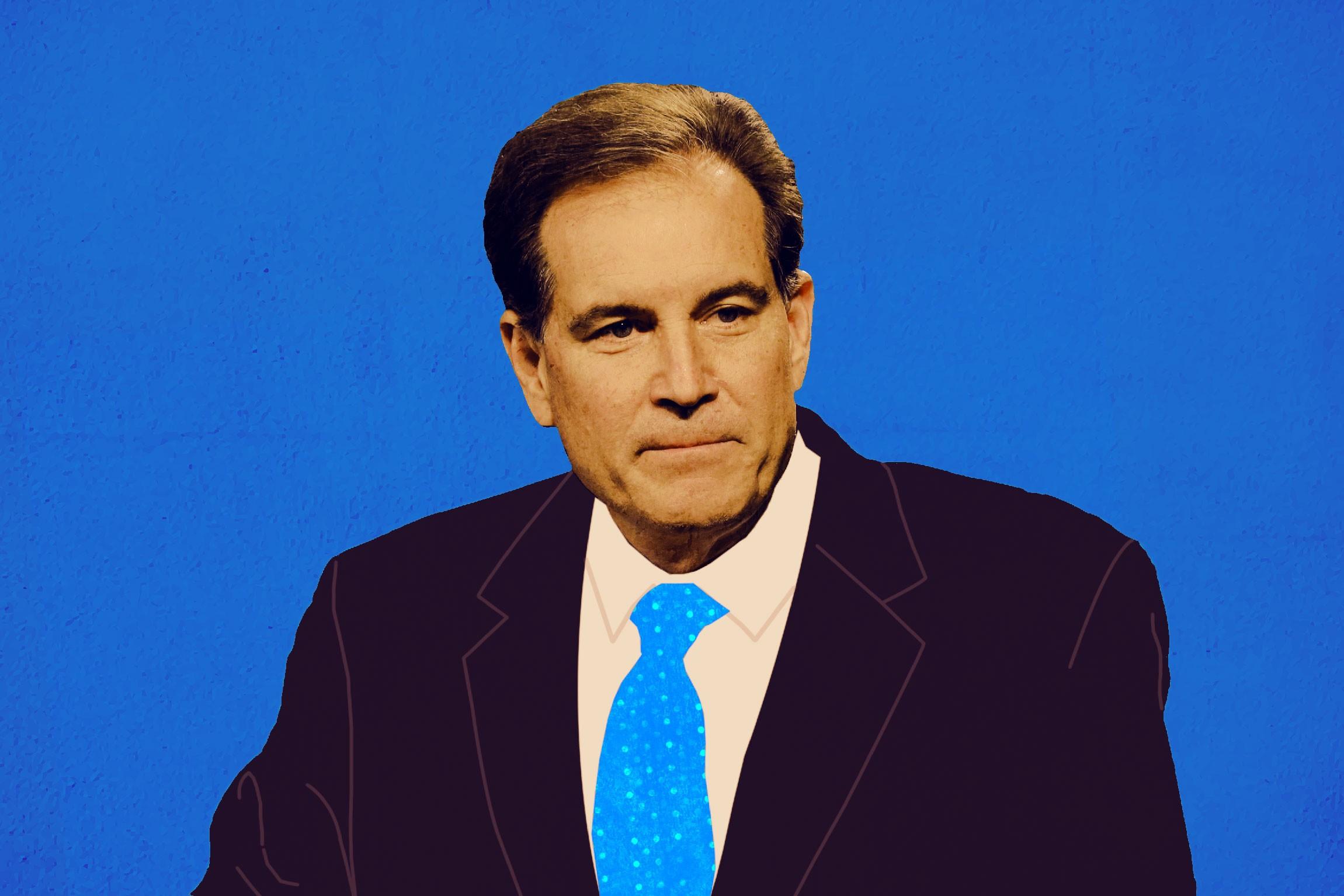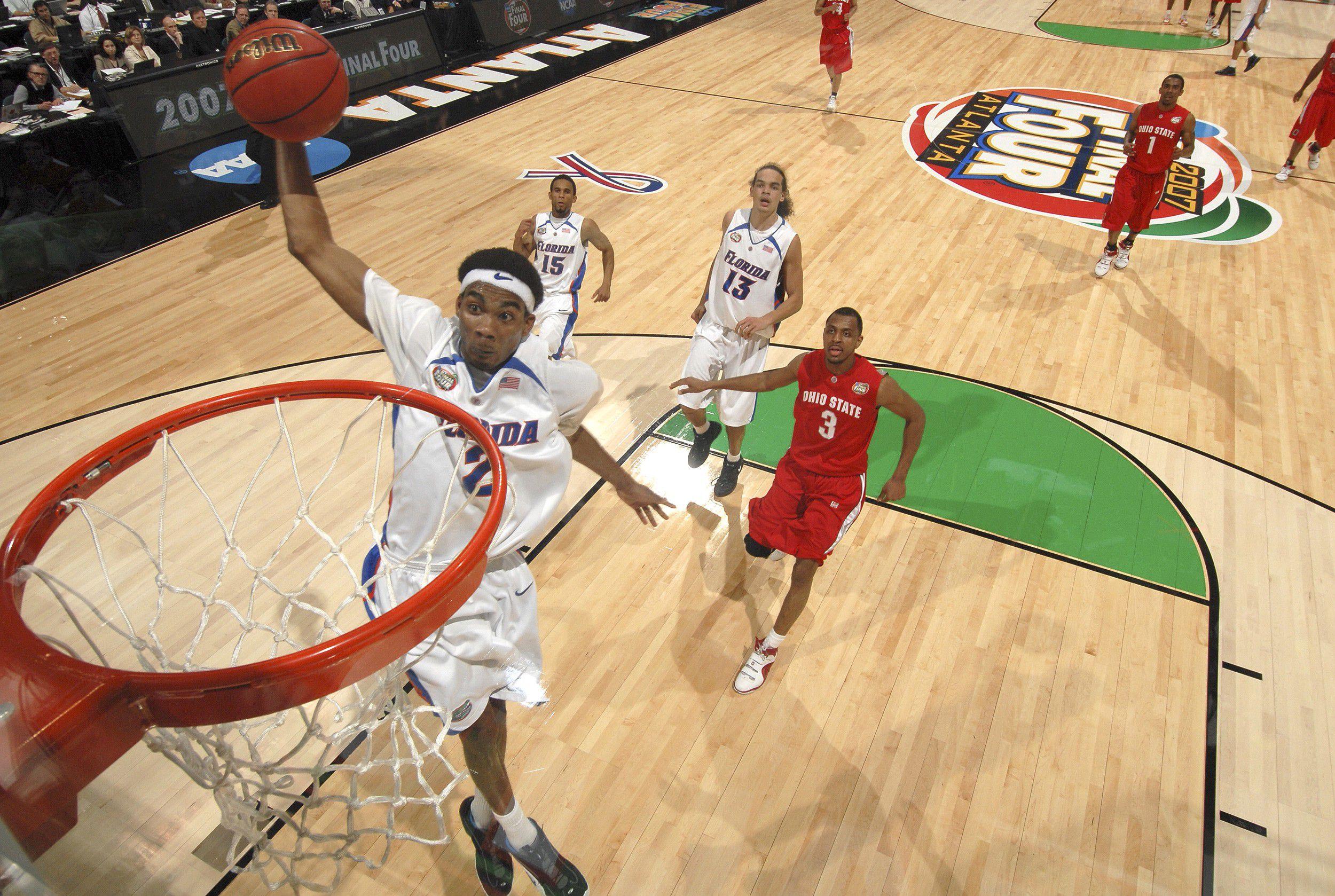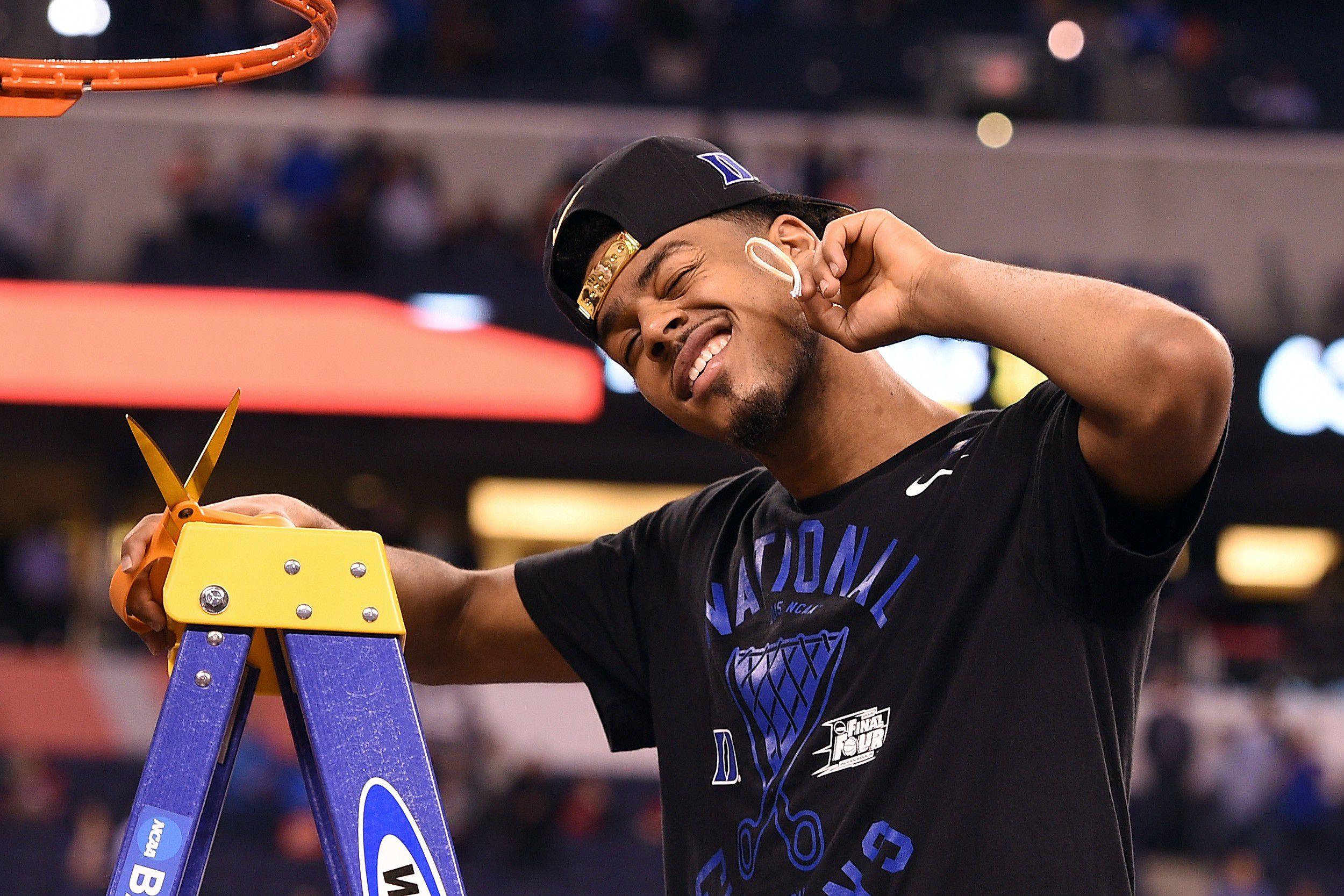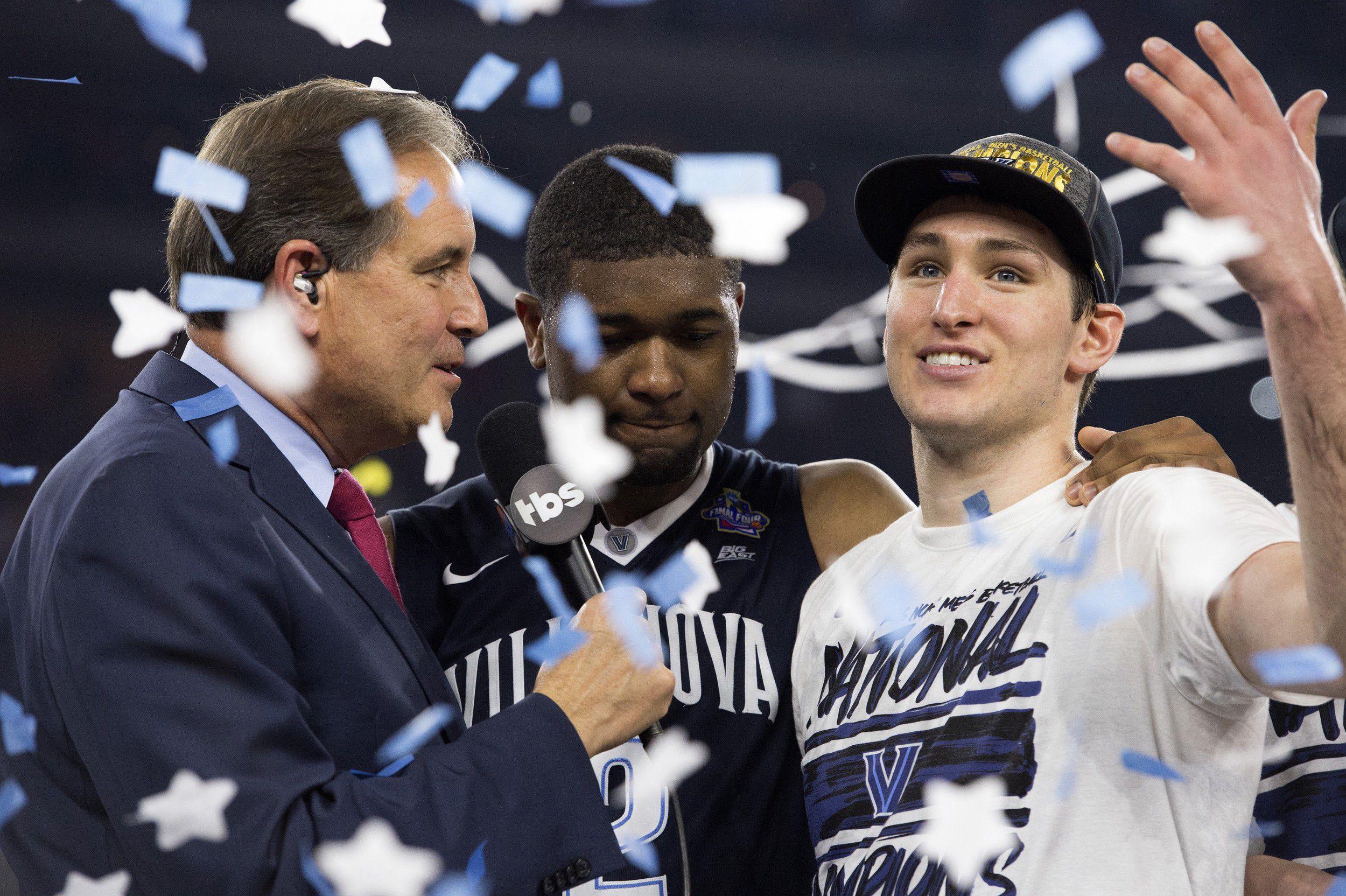Something to Take Home
When CBS college hoops announcer Jim Nantz gave Villanova’s Ryan Arcidiacono his tie at the end of last year’s tournament, some rolled their eyes at the corniness. But there’s more to the story, according to Nantz. And it’s a tradition unlike any other.
This is how Jim Nantz’s seemingly zany and haughty tradition — one could call it a tradition unlike any other — of giving away ties to college basketball players first got started, at least according to Nantz. It was the weekend of the 2006 Final Four. Actually, let’s go back even earlier, or “pause the tape” — a phrase Nantz likes to use in conversation before interjecting an alternate thought into a monologue — and consider all the different motives Nantz says he has for handing over to college basketball players a piece of neckwear. After all, there are many reasons, some of which you may be familiar with, others, well, probably not.
First, there’s Nantz’s well-documented relationship with his father, Jim Nantz II. “Dad,” as Nantz refers to him in conversations, even with strangers such as myself, was the inspiration for Nantz’s 2008 book, Always by My Side: A Father’s Grace and a Sports Journey Unlike Any Other. The book is essentially a love letter from “Jimmy,” the moniker Nantz said he goes by outside of his professional life, to Jim. Nantz II lived with Alzheimer’s for 13 years before dying at the age of 79, a month after the release of the book, which contains the following passage explaining Nantz’s emotional connection to neckties:
And here’s what Nantz said to a Houston TV station (more on that in a bit) following last year’s national championship game after a reporter saw him take off his tie and hand it to Villanova guard Ryan Arcidiacono. The clip was posted to the internet and soon went viral. “Jim Nantz, A Tremendous Weirdo, Gave His Tie To Ryan Arcidiacono,” was the headline on Deadspin; Sporting News countered with “Jim Nantz Forced Ryan Arcidiacono to Take His Tie in the Worst Final Four Tradition.”
“The tie symbolizes a lot to me; my father, who taught me how to tie a tie,” Nantz says in the video. “I just felt years ago that I wanted to do something to honor a senior on the team that wins the title, to give them something to take home.”
So there’s all that, but more: Nantz, though, was leery of opening up too much when we spoke at the CBS/Turner NCAA tournament media day. “Please, don’t take this out of context,” he pleaded prior to sharing anecdotes, such as the following: Nantz has lived a fruitful life. He’s been the voice of the Masters since 1989 and the Final Four since 1991. He’s called Super Bowls, won awards, and been honored by the Basketball Hall of Fame, and when you’re a well-compensated stalwart of the sports media, you get to meet and spend time with A-listers from all walks of life.
“I mean, you can come up with the biggest names in the world, and I’ve been lucky enough being along for the ride,” Nantz said. “I’m not, in any fashion, comparing my little world as a sports commentator to what they do. I am not a former president of the United States — please don’t take this out of context. But I’m lucky enough to call some former presidents” — George H.W. Bush, George W. Bush, and Bill Clinton — “my friends.”
What does this have to do with neckties? The way Nantz tells it, there were times when he’d be golfing with President Clinton and someone would approach the former president and introduce themselves, and Clinton, as a parting gift, would remove his cuff links and hand them over as a keepsake. Then there was Arnold Palmer, someone Nantz described as “a father figure,” who, according to Nantz, would take extra care to make sure the autograph he was giving was just perfect, and then he’d take the umbrella pen he’d just used and stick it in the fan’s lapel.
“It’s impressive,” Nantz said, “and I saw the impression it made on people.”

So let’s go back to the 2006 Final Four in Indianapolis. Nantz was there as part of CBS’s top broadcast group. He wound up calling a bunch of Florida Gators games that season. Three of that team’s best players — Joakim Noah, Al Horford, and Taurean Green — had “famous” fathers, a story line Nantz remembered the media jumping on during the school’s title run. “All of us contributed to that being the defining theme of that team,” Nantz said. “From the stories written on them, to my commentary, to the cut-away shots of the famous fathers cheering.”
One day, Nantz was speaking with Florida’s then–associate sports information director, Fred Demarest. According to Nantz, Demarest was effusive about what a great kid Corey Brewer was, how he was everything you look for in a college athlete. “I’d like to get to know him,” Nantz recalled saying. A meeting was set up. Nantz asked Brewer if his father was coming to the Final Four, to which Brewer responded no, he had been dealing with some medical issues, the result of diabetes.
“Corey,” Nantz recalled telling him, “my suspicion is you love your dad as much as these other kids who are getting a lot of attention.” Nantz then promised that he’d pass along “best wishes” to Brewer’s dad during the broadcast. He did, and after Florida knocked off UCLA in the championship game, Nantz found Brewer on the floor.
“I told him I mentioned his father on the air, and he was so excited,” Nantz said. “So I told him, ‘You’re a special young man and I can’t thank you enough for the time you gave me yesterday,’ and I gave him my tie. I didn’t think anything of it.” Nantz told me he had given away ties before, but always to autograph seekers, broadcast students, or fans, not actors in the games he called.
The next year Florida was back in the Final Four. There, Nantz approached Demarest (who didn’t respond to an email for comment). He was curious what Brewer had done with the tie.
“He said, ‘Are you kidding? It hangs in his locker on a hook,’” Nantz recalled. “I knew then that it meant something to him.”
And that’s how another tradition unlike any other was born.

This story was supposed to be one poking fun at Nantz, or at least the notion of a rich, crusty, middle-aged white man handing over ties to younger and mostly black athletes who help line Nantz’s pockets while taking home no cash themselves. The goal was to speak to some of the players who have received ties from Nantz, document how strange they thought it was when Nantz approached with tie in hand, and how they soon after tossed the tie in the trash, never to think about it again.
Thing is, that’s not how they’ve reacted. Take Brewer, for example. “I thought the whole thing was really cool,” he said over the phone earlier this month. “It’s Jim Nantz, he does all the big games, everyone knows who he is.” Brewer had trouble recalling all the details of his interactions with Nantz, but he did remember bringing it back to his parents’ Portland, Tennessee, home that summer. His mom stashed the pink tie in a trophy case in the house’s TV room, where it’s draped over the Gold Ball he received after Florida won the 2K Classic in 2005.
“I never wore it,” Brewer said. “It was like a trophy, like a keepsake.”

Quinn Cook’s reaction was similar to Brewer’s. He was the tie recipient after Duke won the national championship in 2015. In a phone interview, he said he remembers Nantz pulling him aside after the “One Shining Moment” video.
“He told me how every year he gives his tie to the person most deserving, and that he felt I deserved it that year,” Cook said. “I told him how much that meant to me, then gave him a big hug and then gave the tie over to my mom.” Janet Cook wrapped the navy tie around her neck; she hasn’t given it up since. Cook said it’s still in his mother’s home, in a glass trophy case. “I think it’s a cool thing he does,” Cook added. “When I think of the Final Four I think of CBS and his voice — I treated that tie as an award, as a trophy. It was a big moment.”
The only player I spoke with who hadn’t treated the tie as a sacred possession but rather with a bit of indifference was the man somewhat responsible for bringing this story into the spotlight.
“I think that the tie is at my house … somewhere with all of my other items I saved from the final four,” Arcidiacono wrote in an email. “I remember I had it right after the game and when I got back to my room on campus I just had it in my room in a dresser.” Arcidiacono also let his roommate/teammate, Patrick Farrell, wear the tie out the following evening, but the lack of reverence in his comments don’t quite jibe with Arcidiacono’s immediate reaction. Arcidiacono kept Nantz’s solid-red tie on him while reveling in what was probably the greatest moment and night of his life. He wore it while being interviewed at his locker, and then during his postgame press conference in the media room, where he revealed Nantz’s tradition to the world.


“He said, ‘At the end of the tournament I always go to the winning team and I pick a senior who has inspired him throughout the tournament.’ He gives him the tie at the end,” he told reporters. “He said it was me. I was just in awe. I didn’t know what to say. It was just a great honor from a really nice person.”
As for the other tie recipients: Representatives for Peyton Siva, to whom Nantz gave a tie after Louisville won in 2013, didn’t respond to a request for comment, and I wasn’t able to speak to Kyle Singler (Duke, 2010) before publishing. Darius Miller (Kentucky, 2012), didn’t respond to multiple emails, and neither Nantz nor school SIDs could recall who Nantz had given ties to in the remaining six years, though Nantz previously said Mario Chalmers and Kyle Singler had been recipients. North Carolina was “pretty sure” Ty Lawson got one in 2009, but Lawson declined to comment. Perhaps some of them feel similarly to Arcidiacono.

Let’s get back to Nantz, who might as well have kicked off our chat with a great, big, “Hello, friend.”
Nantz knew I was coming to speak with him, and he knew what I wanted to talk to him about. CBS Sports’ PR team had given him a heads-up. He spent the first hour-plus of the media event sitting at a round table inside a ballroom in a midtown Manhattan Hilton chatting with various reporters before getting to me. He was told that I was “the writer here about the ties.” I introduced myself; he extended a hand, smiled, and inquired how to pronounce my name. He was wearing a blue-and-white-checkered shirt. No tie. I tried to start the interview. Some questions, I began telling him, were going to be a bit more pointed and I just wanted to give him a heads-up.
“Where are you from?” he asked.
I told him New Rochelle. He said he’s played golf at a course nearby, off the Hutchinson River Parkway in Westchester County, and that he knows the area well. He then asked who I normally write for, and what sports I cover. Then it was whether this interview was going to be a straight Q&A — if so, he’d condense his answers. I answered the questions, before steering the interview back to the topic at hand.
“So I want to give you a chance to respond to the criticism …” I began to say, but he cut me off.
“Criticism?” he asked, with a befuddled look on his face. I told him of his tie-giving tradition.
“Oh,” he said. His shoulders fell and his smile disappeared. He fell back into his chair. Jim Nantz — the stoic and kind voice of American sports — had become sad. It was a strange sight.
Even in an off-the-cuff chat, his stories sound like those belonging to a professional broadcaster. He did most of the talking, like a man who had spent the majority of his life being being paid to do so. In a way, he talks as if he’s on the air, but it doesn’t come off as canned or insincere. It’s just Jim Nantz being Jim Nantz.

He explained the origin of the tie tradition. He expressed genuine appreciation after being told of Brewer’s and Quinn’s comments. He conceded that he probably shouldn’t have given the sound bite on the tie following last year’s championship game, but added that the young reporter who asked him about it was from KHOU, the affiliate in Houston that had hired him to be the backup weekend sports anchor when he was a junior at the University of Houston, and that he had met the reporter earlier in the week, and so how could he say no to a quick interview?
“A lot of people hijacked the narrative on this, made it a public play, drew all kinds of snarky conclusions from it, acted as if I forced it on Ryan,” Nantz said. “But I’m grateful for it, and I’ll tell you why.” He then called over his agent, Alan Zucker. “Zuck,” he said, has been helping him kick-start a new initiative: Nantz’s ties will now be manufactured by Vineyard Vines, with all proceeds going to the Nantz National Alzheimer Center, one of the world’s top Alzheimer’s research centers, which was started by Nantz and Houston Methodist Hospital in 2011.
“I’ve been trying to get all you guys who are interested in things like ties … I have something that I wake up to every day working my fanny off that I can’t get anybody to write about,” Nantz said, slamming his right hand down on the table. He ceased sounding Nantzian. He seemed to be genuinely unsettled. “In sports media I’m the guy who’s throwing ties at people,” he later added. “What’s this guy? What’s he’s about? That’s [Alzheimer’s research] my life.”
His voice then dropped to just above a loud whisper.
“My voice is my dad’s voice,” Nantz said. “I sound exactly like him, but no one ever interviewed him. But I have a recorder in front of me and so my voice on this has to be heard. I can tell you this: If I don’t see Alzheimer’s wiped out before I die, my life will not be successful.”
Nantz had sounded surprised when I mentioned that some had criticized the tie tradition, as if he had never heard this before, yet clearly, based on these comments, he was at least somewhat aware of the public’s perception.
“I don’t think criticism; criticism sounded a little strong,” he said. “I thought people were just trying to have some fun with it.”
I tried bringing up the idea that, at the least, the optics weren’t great, how the NCAA business model is laden with conflicts and immoralities and how one could argue that Nantz, as the voice of the network profiting off this unpaid labor, plays a role in perpetuating the sham of amateurism and that the image of him telling one of these college kids to accept his tie as a reward is an act that could, in theory, be picked apart.
All of this, though, seemed to be news to him. Either that, or it was a view he wasn’t interested in hearing. My guess is it’s the former, but I suppose one can’t be sure. I wasn’t able get the whole question out before he jumped back in.
“I love college kids,” he said. “I have so much respect and appreciation for them and the college experience, and I try to be as involved as I can.”
He had one more story to share: The other day he had called a basketball game at Northwestern, where Chris Collins is the coach. Nantz has known Collins, the son of former NBA head coach and longtime broadcaster Doug Collins, since he was a kid, and so Chris asked Nantz to speak to the basketball team in private. He thought they could benefit by hearing from the Voice of College Basketball, and Nantz was happy to oblige.
“These are college kids, these aren’t professional basketball players,” Nantz told me. “The kids that I see, that I handed ties to, they’re special people. It was never a matter of forcing anything on them, it was a sign of respect. It was me saying, ‘I respect what you did. If you’d like to have a piece of memorabilia from the Final Four, this is the best I can offer.’”
After about 30 minutes, a CBS employee stepped in to end the interview. Nantz, he said, had to go do a TV hit. “I’m not worried about that, honest to God. I want to get right here with this first,” Nantz said. Eventually, though, he had to go. He was ushered into another room, after which three PR staffers and Zucker, his agent, approached me.
“That was the most emotional I think I’ve ever seen him,” Zucker said. “When he was talking about his dad, his voice was so low I didn’t think your recorder would pick it up.”
It did. Every word.